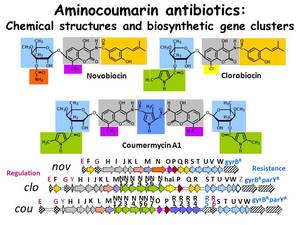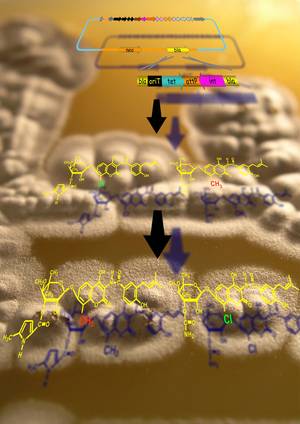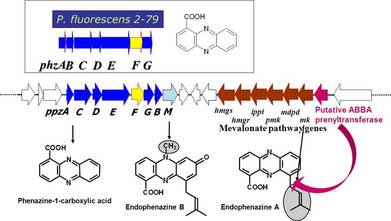B) Antibiotic discovery with genetic and genomic methods
Synthetic Biology of Microbial Bioactive Compounds
Antibiotic resistance is a major problem worldwide, and there is an urgent need for new antibiotics to be developed. In the past, most of the currently used antibiotics have been discovered by screening of microorganisms. However, as many of the accessible microorganisms have been screened already, it becomes more and more difficult to discover new therapeutics following this approach. Our group now works on genetic ways to engineer soil bacteria of the genus Streptomyces to produce new bioactive compounds, especially antibiotics and anticancer compounds. Streptomyces bacteria naturally make antibiotics, e.g. to kill competing other bacteria in the soil. We are interested in the discovery of the genetic information which enables Streptomyces bacteria to produce these bioactive compound, in the chemical and biochemical elucidation of the biosynthetic pathways leading to these compounds, and subsequently in the development genetic methods for the modification of Streptomyces bacteria in order to generate new antibiotics and anticancer compounds which may present useful drugs for human therapy.
Selected publications of our group describing this research area:
- Alt S, Burkard N, Kulik A, Grond S, Heide L (2011) An artificial pathway to 3,4-dihydroxybenzoic acid allows generation of a new aminocoumarin antibiotic recognized by catechol transporters of E. coli. Chem Biol 18: 304-313. (This paper was highlighted in Nature Biotechnology 2011, 29: 410 )
- Heide L (2009) Genetic engineering of antibiotic biosynthesis for the generation of new aminocoumarins. Biotechnol Adv 27: 1006-1014.
Gyrase inhibitors, aminocoumarin antibiotics
The aminocoumarin antibiotics novobiocin, clorobiocin and coumermycin A1 kill bacteria by inhibition of the enzymes gyrase and topoisomerase IV, which are essential for the control of gene activity in bacteria. Novobiocin has been introduced into human therapy in the United States (Albamycin).
 Streptomyces bacteria, like most microorganisms, offer a great advantage to the researcher: the biosynthetic genes for a specific antibiotic (secondary metabolite) are clustered in a well-defined, contiguous region - the biosynthetic gene cluster of that metabolite.
Streptomyces bacteria, like most microorganisms, offer a great advantage to the researcher: the biosynthetic genes for a specific antibiotic (secondary metabolite) are clustered in a well-defined, contiguous region - the biosynthetic gene cluster of that metabolite.
We have cloned and sequenced the biosynthetic gene clusters of the three above-mentioned aminocoumarin antibiotics. By gene inactivation experiments, heterologous expression experiments and biochemical investigations, we have been able to elucidate the function of nearly all of the biosynthetic genes contained in these gene clusters, thereby expanding our understanding of how such compounds are formed by microorganisms.
 Comparison of the gene clusters of the three aminocoumarin antibiotics revealed a striking correspondence between the structures of the antibiotics and the organization of the biosynthetic genes. For each structural moiety of the aminocoumarin antibiotics, the biosynthetic genes are grouped together, resulting in a "modular" structure of the clusters. The orders of the modules, and the order of the genes within each module, are identical for these three aminocoumarins. Transfer of the entire biosynthetic gene clusters of novobiocin and clorobiocin to other Streptomyces strains resulted in the formation of these antibiotics by the engineered host organisms, and provided excellent opportunities for the production of new aminocoumarins by genetic methods. The aminocoumarin antibiotics have become a successful model for the generation of new antibiotics by genetic engineering and synthetic biology.
Comparison of the gene clusters of the three aminocoumarin antibiotics revealed a striking correspondence between the structures of the antibiotics and the organization of the biosynthetic genes. For each structural moiety of the aminocoumarin antibiotics, the biosynthetic genes are grouped together, resulting in a "modular" structure of the clusters. The orders of the modules, and the order of the genes within each module, are identical for these three aminocoumarins. Transfer of the entire biosynthetic gene clusters of novobiocin and clorobiocin to other Streptomyces strains resulted in the formation of these antibiotics by the engineered host organisms, and provided excellent opportunities for the production of new aminocoumarins by genetic methods. The aminocoumarin antibiotics have become a successful model for the generation of new antibiotics by genetic engineering and synthetic biology.
Many new aminocoumarins could be produced by targeted genetic manipulation in the natural producer strains, and also in heterologous host Streptomyces coelicolor after expression of the respective gene cluster. Production of new aminocoumarins was also achieved by mutasynthesis experiments and by chemoenzymatic synthesis in vitro. This allowed to elucidate the structure-activity relationships in the class of aminocoumarin antibiotics.
Selected publications of our group describing this research area:
- Boll B, Taubitz T, Heide L (2011) The role of MbtH-like proteins in the adenylation of tyrosine during aminocoumarin and vancomycin biosynthesis. J. Biol. Chem. 286: 36281-36290
- Alt S, Mitchenall L, Maxwell A, Heide L: Inhibition of DNA gyrase and DNA topoisomerase IV of Staphylococcus aureus and Escherichia coli by aminocoumarin antibiotics (2011) J Antimicrob Chemother 66: 2061-2069
- Heide L (2009) The aminocoumarins: biosynthesis and biology. Nat Prod Rep 26:1241-1250
Phenazine antibiotics
Phenazine natural products show antibacterial, antitumor and antimalarial activity. They are inhibitors of angiotensin-converting enzyme and steroid 5-α-reductase. Some other of the naturally occurring phenazines are bacterial virulence factors, important for pathogenesis during an infection. The synthetic phenazine clofazimine has been approved for human therapy in the treatment of leprosy.
Besides their role as antibiotics and virulence factors, phenazines have a variety of biological functions for the producing bacterium, often related to their capability to shuttle electrons by reversible oxidation and reduction. Phenazine biosynthesis is limited to the actinobacteria (e.g. Streptomyces), certain groups of Gram-negative proteobacteria (e.g. Pseudomonas) and a few archaea. Pseudomonas strains produce simple phenazines such as phenazine-1-carboxylic acid (PCA) and phenazine-1-carboxamide (PCN). In contrast, Streptomyces strains can form more complex phenazines with very diverse substitution patterns of the phenazine core.
<span style="font-size:12.0pt; line-height:115%; font-family:Arial"> </span>
</span>
Our group has identified the first biosynthetic gene clusters for phenazines from Streptomycetes. Heterologous expression of these cluster in Streptomyces coelicolor M512 yielded phenazines in similar amounts as formed by the wild-type producer strain. We carried out inactivation experiments of genes in these clusters, followed by heterologous expression of the modified clusters and chemical analysis of secondary metabolite formation. This allowed us to investigate the function of individual genes for the biosynthetic pathway and for its regulation, and the identification of a new resistance mechanism against phenazines which is likely to offer a competitive advantage to a Streptomyces strain in nature.
Selected publications of our group describing this research area:
- Saleh O, Bonitz T, Flinspach K, Kulik A, Burkard N, Mühlenweg A, Vente A, Polnick S, Lämmerhofer M, Gust B, Fiedler HF, Heide L (2012) Activation of a silent phenazine biosynthetic gene cluster reveals a novel natural product and a new resistance mechanism against phenazines. MedChemComm3: 1009-1019
- Saleh O, Flinspach K, Westrich L, Kulik A, Gust B, Fiedler HP, Heide L (2012) Mutational analysis of a phenazine biosynthetic gene cluster in Streptomyces anulatus 9663. Beilstein J Org Chem 8: 501-513
- Seeger K, Flinspach K, Haug-Schifferdecker E, Kulik A, Gust B, Fiedler HP, Heide L (2010) The biosynthetic genes for prenylated phenazines are located at two different chromosomal loci of Streptomyces cinnamonensis DSM 1042. Microb Biotechnol 4: 252-262
Prenyltransferases with aromatic substrates
Aromatic prenyltransferases catalyze the transfer of isoprenyl moieties to aromatic acceptor molecules. They are key enzymes for the generation of a huge diversity of primary and secondary metabolites in bacteria, fungi and plants, including important pharmaceuticals and toxins. Our group has contributed to the discovery of a new family of aromatic prenyltransferases. These enzymes show a unique three-dimensional structure, called PT-barrel fold. The PT-barrel is found exclusively in microbial secondary metabolic prenyltransferases with aromatic substrates. For proteins with the PT-barrel fold, the name ABBA PTases has been suggested, owing to the αββα succession of the secondary structure elements in the polypeptide chain which results in the characteristic antiparallel orientation of the β-sheets in the barrel. These soluble aromatic prenyltransferases show remarkable promiscuity for their aromatic substrates and can be used for the chemoenzymatic synthesis of new prenylated aromatic compounds. They represent promising tools for biotechnological and pharmaceutical research.
Selected publications of our group describing this research area:
- Bonitz T, Alva V, Saleh O, Lupas AN, Heide L (2011) Evolutionary relationships of microbial aromatic prenyltransferases. PLoS One. 6(11):e27336
- Metzger U, Schall C, Zocher G, Unsöld I, Stec E, Li SM, Heide L, Stehle T (2009) The structure of dimethylallyl tryptophan synthase reveals a common architecture of aromatic prenyltransferases in fungi and bacteria. Proc Nat Acad Sci (USA) 106:14309-14314
- Heide L (2009) Prenyl transfer to aromatic substrates: genetics and enzymology. Curr Opin Chem Biol 13: 171-179
